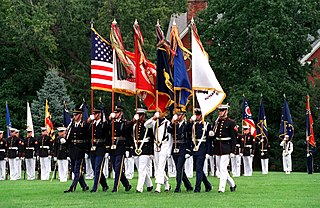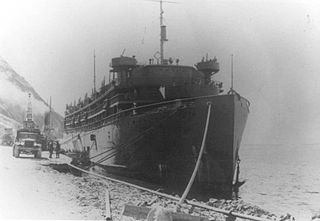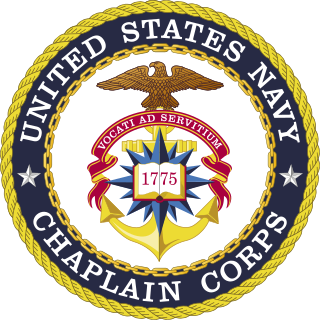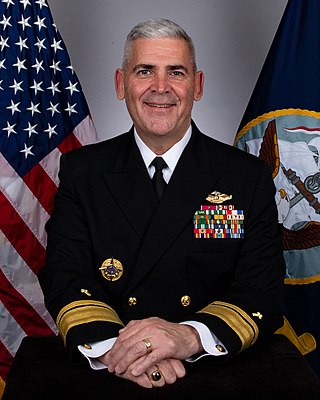
The United States Coast Guard (USCG) is the maritime security, search and rescue, and law enforcement service branch of the United States Armed Forces and one of the country's eight uniformed services. The service is a maritime, military, multi-mission service unique among the United States military branches for having a maritime law enforcement mission with jurisdiction in both domestic and international waters and a federal regulatory agency mission as part of its duties. It is the largest coast guard in the world, rivaling the capabilities and size of most navies.
Commander is a common naval officer rank as well as a job title in many armies. Commander is also used as a rank or title in other formal organizations, including several police forces. In several countries this naval rank is termed frigate captain.

The several branches of the United States Armed Forces are represented by flags. Within the U.S. military, various flags fly on various occasions, and on various ships, bases, camps, and military academies.

Dorchester was a coastal passenger steamship requisitioned and operated by the War Shipping Administration (WSA) in January 1942 for wartime use as a troop ship allocated to United States Army requirements. The ship was operated for WSA by its agent Atlantic, Gulf & West Indies Steamship Lines (Agwilines). The ship was in convoy SG 19 from New York to Greenland transiting the Labrador Sea when it was torpedoed by a German U-boat on February 3, 1943. The ship sank with loss of 674 of the 904 on board with one of the 230 survivors lost after rescue. The story of four Army chaplains, known as the "Four Chaplains" or the "Immortal Chaplains," who all gave away their life jackets to save others before they died, gained fame and led to many memorials.

The United States Coast Guard Academy (USCGA), located in New London, Connecticut, is the U.S. service academy specifically for the United States Coast Guard. Founded in 1876, the academy provides education to future Coast Guard officers in one of nine major fields of study.

The United States Coast Guard Reserve is the reserve component of the United States Coast Guard. It is organized, trained, administered, and supplied under the direction of the Commandant of the Coast Guard through the Assistant Commandant for Reserve (CG-R).

The United States Navy Chaplain Corps is the body of military chaplains of the United States Navy who are commissioned naval officers. Their principal purpose is "to promote the spiritual, religious, moral, and personal well-being of the members of the Department of the Navy," which includes the Navy and the United States Marine Corps. Additionally, the Chaplain Corps provides chaplains to the United States Coast Guard.
In the United States Armed Forces, a line officer or officer of the line is a U.S. Navy or U.S. Marine Corps commissioned officer or warrant officer who exercises general command authority and is eligible for operational command positions, as opposed to officers who normally exercise command authority only within a Navy Staff Corps. The term line officer is also used by the U.S. Air Force and U.S. Coast Guard to indicate that an officer is eligible for command of operational, viz., tactical or combat units. The term is not generally used by officers of the U.S. Army – the roughly corresponding Army terms are basic branch and special branch qualified officers, although the concepts are not entirely synonymous, as some Army special branch officers are eligible to hold command outside their branch specialty.

USS Weeden (DE-797) was a Buckley-class destroyer escort in service with the United States Navy from 1944 to 1946 and from 1950 to 1958. She was scrapped in 1969.

The United States Army Chaplain Corps (USACC) consists of ordained clergy of multiple faiths who are commissioned Army officers serving as military chaplains as well as enlisted soldiers who serve as assistants. Their purpose is to offer religious church services, counseling, and moral support to the armed forces, whether in peacetime or at war.
The structure of the United States Navy consists of four main bodies: the Office of the Secretary of the Navy, the Office of the Chief of Naval Operations, the operating forces, and the Shore Establishment.
The Chaplain of the United States Coast Guard (COCG) is the senior chaplain of the United States Coast Guard (USCG) and is attached to USCG headquarters in Washington, D.C. as a United States Navy Chaplain Corps officer who reports directly to the Commandant of the Coast Guard. The current interim Chaplain of the Coast Guard is Richard Ryan, Coast Guard Atlantic Area Chaplain.
Hispanics in the United States Coast Guard can trace their tradition of service to the early 19th century, when they initially performed duties at light house stations as keepers and assistant keepers in its predecessor services. Hispanic is an ethnic term employed to categorize any citizen or resident of the United States, of any racial background, of any country, and of any religion, who has at least one ancestor from the people of Spain or is of non-Hispanic origin, but has an ancestor from Mexico, Puerto Rico, Cuba, Central or South America, or some other Hispanic origin. The three largest Hispanic groups in the United States are the Mexican-Americans, Puerto Ricans, and Cubans.

The Chief of Chaplains of the United States Navy (CHC) is the highest-ranking military chaplain in the United States Navy and head of the United States Navy Chaplain Corps. As part of the Office of the Chief of Naval Operations and Department of the Navy, the CHC is dual-hatted as the Director of Religious Ministries (N097) under OPNAV. In these capacities, the CHC is the principal advisor to the secretary of the Navy, the chief of naval operations and, where appropriate, the commandant of the Marine Corps and commandant of the Coast Guard "on all matters pertaining to religion within the Navy, United States Marine Corps, and United States Coast Guard." For administrative and personnel matters, the CHC reports to the chief of naval personnel.
In the United States armed forces, the Chiefs of Chaplains of the United States are the senior service chaplains who lead and represent the Chaplain Corps of the United States Army, Navy, and Air Force. The Navy created the first Office of the Chief of Chaplains in 1917; the Army followed in 1920, and the Air Force established its own in 1948 after it became a separate branch.

Margaret Grun Kibben is a U.S. Presbyterian minister who is the chaplain of the United States House of Representatives. She served as the 26th Chief of Chaplains of the United States Navy from 2014 to 2018; she was formerly the 18th Chaplain of the United States Marine Corps (CHMC) and the Deputy Chief of Chaplains of the United States Navy from 2010 to 2014. Kibben was the first woman to hold each of these positions.

The Chaplain of the United States Marine Corps (CHMC) is a position always filled by the officers serving as Deputy Chief of Chaplains of the United States Navy as a "dual hatted" billet since 2000. The CHMC oversees religious ministry in the Marine Corps which one Commandant of the Marine Corps defined as "a vital function which enhances the personal, family, and community readiness of our Marines, sailors, and their families. Chaplaincy supports the foundational principle of free exercise of religion and helps to enrich the spiritual, moral and ethical fabric of the military."

George C. Allen II is a former brigadier general in the Delaware Air National Guard and Air National Guard Assistant to the Chief of Chaplains of the United States Air Force.

Gregory N. Todd is a United States Navy rear admiral and chaplain who serves as the 28th Chief of Chaplains of the United States Navy. He previously served as the 20th Chaplain of the Marine Corps. He also served for four years as the tenth Chaplain of the Coast Guard. Over a thirty-two year career, he has served in a variety of Navy, Marine Corps, and Coast Guard assignments, including deployments to Iraq and Afghanistan and chaplaincy work at Ground Zero in the wake of the September 11 attacks. He is a Lutheran.












